
Milan is a town in Dutchess County, New York, United States. The town is in the northern part of the county and is very rural. As of the 2020 census it had a population of 2,245, slightly down from 2,370 in 2010. Milan is located approximately 90 miles (140 km) north of New York City, 60 miles (97 km) south of Albany, and 150 miles (240 km) west of Boston. It is bordered by Rhinebeck and Red Hook to the west, Pine Plains to the east, Stanford to the southeast, Clinton to the south, and Gallatin to the north by Columbia County. The only major route in the town is the historic Taconic State Parkway, though NY 199 serves as the main local thoroughfare.

New York State Route 17 (NY 17) is a major state highway that extends for 397 miles (638.91 km) through the Southern Tier and Downstate regions of New York in the United States. It begins at the Pennsylvania state line in Mina and follows the Southern Tier Expressway east through Corning to Binghamton and the Quickway from Binghamton east to Woodbury, where it turns south to follow the Orange Turnpike to the New Jersey state line near Suffern, where it connects to New Jersey Route 17. From the Pennsylvania border to the village of Waverly and from Binghamton to Windsor, NY 17 is concurrent with Interstate 86 (I-86). Eventually, the entire east–west portion of NY 17 from the Pennsylvania border to Woodbury will become I-86 as projects to upgrade the route to Interstate Highway standards are completed.

New York State Route 28 (NY 28) is a state highway extending for 281.69 miles (453.34 km) in the shape of a "C" between the Hudson Valley city of Kingston and southern Warren County in the U.S. state of New York. Along the way, it intersects several major routes, including Interstate 88 (I-88), U.S. Route 20 (US 20), and the New York State Thruway twice. The southern terminus of NY 28 is at NY 32 in Kingston and the northern terminus is at US 9 in Warrensburg. In Kingston, NY 28 is co-designated as Interstate 587 from its southern terminus at NY 32 to the roundabout linking it to the Thruway (I-87).
Shunpiking is the act of deliberately avoiding roads that require payment of a fee or toll to travel on them, usually by traveling on alternative "free" roads which bypass the toll road. The term comes from the word shun, meaning "to avoid", and pike, a term referring to turnpikes, which is another name for toll roads. People who often avoid toll roads sometimes call themselves shunpikers. Historically, certain paths around tollbooths came to be so well known they were called "shun-pikes".

New York State Route 199 is a 30.91-mile-long (49.74 km) state highway located in the Hudson Valley of the U.S. state of New York. Its western end is in Ulster County, where it begins as the continuation of the short U.S. Route 209 expressway east of its interchange with U.S. Route 9W; after crossing the Kingston–Rhinecliff Bridge over the Hudson River the rest of the highway crosses northern Dutchess County. As it does it passes through downtown Red Hook and Pine Plains, reaching its eastern end at U.S. Route 44 and State Route 22 southwest of Millerton in the upper Harlem Valley.

New York State Route 301 (NY 301), also known as the Hudson River Turnpike, is an intra-county state highway stretching across three-quarters of Putnam County, New York, in the United States. The western terminus of NY 301 is at an intersection with NY 9D in Cold Spring. Its eastern terminus is at a junction with NY 52 in Carmel. Along the way, NY 301 meets U.S. Route 9 (US 9) and the Taconic State Parkway and passes through Clarence Fahnestock State Park. The section of the route between NY 9D and US 9 is ceremonially designated as the Sergeant Albert Ireland Memorial Highway.
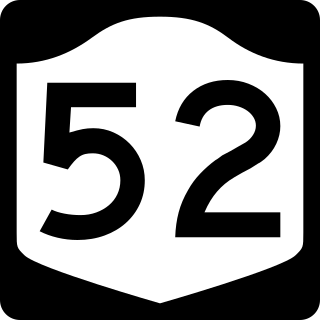
New York State Route 52 (NY 52) is a 108.72-mile-long (174.97 km) state highway in the southeastern part of the state. It generally runs from west to east through five counties, beginning at the Pennsylvania state line in the Delaware River near Narrowsburg, crossing the Hudson River on the Newburgh–Beacon Bridge, and ending in Carmel. NY 52 and NY 55, both major east–west routes of the Mid-Hudson Region, run parallel to each other, intersecting in downtown Liberty.

New York State Route 55 (NY 55) is a 122.45-mile-long (197.06 km) east-west state highway in southern New York, running from the Pennsylvania state line at the Delaware River in Barryville to the Connecticut state line at Wingdale. It is the only other state highway beside NY 7 to completely cross the state, from border to border, in an east–west direction, although NY 17 does so and is partially east–west. It also forms a concurrency when it joins US 44 for 33 miles (53 km).
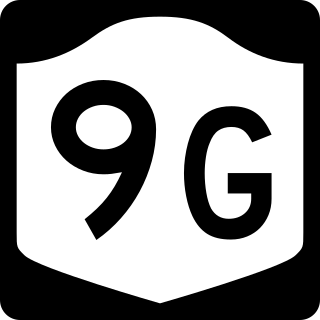
New York State Route 9G (NY 9G) is a state highway in the Hudson Valley of New York in the United States. It runs north from U.S. Route 9 (US 9) at Poughkeepsie, starting out as Violet Avenue, then follows the Hudson River mostly along the eastern side of the US 9 to Rhinebeck, where the two routes cross just north of the village. From this point onward, NY 9G runs on the western side of US 9, closer to the Hudson River, to Hudson. It ends at another junction with US 9 in the city. NY 9G initially extended from Rhinebeck to Hudson when it was assigned as part of the 1930 renumbering of state highways in New York. It was extended to its current length in the late 1930s, supplanting New York State Route 9F, an alternate route of US 9 between Poughkeepsie and Rhinebeck.

New York State Route 82 (NY 82) is a state highway in the eastern Hudson Valley of New York in the United States. It begins at an junction with NY 52 northeast of the village of Fishkill, bends eastward towards Millbrook, and then returns westward to end at a junction with U.S. Route 9, NY 9H, and NY 23 at Bell Pond, near Claverack. NY 82 meets the Taconic State Parkway twice; it is the only state highway that has more than one exit with the parkway. The road spans two counties: Dutchess and Columbia.

New York State Route 308 (NY 308) is a short state highway, 6.19 miles (9.96 km) in length, located entirely in northern Dutchess County, in the U.S. state of New York. It is a major collector road through a mostly rural area, serving primarily as a shortcut for traffic from the two main north–south routes in the area, U.S. Route 9 (US 9) and NY 9G, to get to NY 199 and the Taconic State Parkway. The western end of NY 308 is located within Rhinebeck's historic district, a 2.6-square-mile (6.7 km2) historic district comprising 272 historical structures. The highway passes near the Dutchess County Fairgrounds, several historical landmarks, and briefly parallels the Landsman Kill.
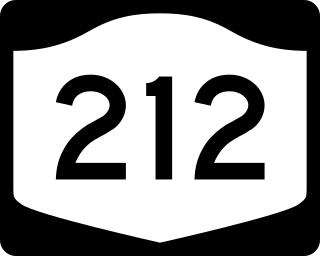
New York State Route 212 (NY 212) is an east–west state highway located entirely within Ulster County, New York, in the United States. It runs for 21.92 miles (35.28 km) from an intersection with NY 28 in the interior of the Catskill Park to a junction with U.S. Route 9W (US 9W) and NY 32 on the west bank of the Hudson River, providing a key interchange with the New York State Thruway along the way. The mostly rural two-lane route serves the communities of Woodstock and Saugerties while passing Cooper Lake, Kingston's reservoir. NY 212 was assigned as part of the 1930 renumbering of state highways in New York.

New York State Route 79 (NY 79) is a 93.18-mile-long (149.96 km) east–west state highway in the Southern Tier of New York, in the United States. The western terminus of the route is at the intersection with NY 414 near the southern end of Seneca Lake just northeast of Watkins Glen. Its eastern terminus is at the Pennsylvania state line in the town of Windsor in Broome County, where it connects to Pennsylvania Route 92 (PA 92). NY 79 passes through three regions; it starts in the Finger Lakes region, runs through Central New York and ends on the western fringes of the Catskills. The route is signed east–west, but from Whitney Point to the state line it runs in a north–south orientation and is signed north–south a few miles south of Center Village, a hamlet that is a few miles south of Harpursville.

New York State Route 206 (NY 206) is a 74.57-mile-long (120.01 km) state highway in the Southern Tier of New York in the United States. It runs through some lightly populated regions along the state's southern border, from Central New York to the Catskills. It begins near a busy intersection with Interstate 81 (I-81) at Whitney Point and runs east from there through Greene. The eastern terminus is located at a junction with NY 17 at Roscoe in Sullivan County. It is one of the longest three-digit routes in New York, and the only long one not associated with a two-digit route or a former U.S. Route. Yet due to its location it sees little traffic, although for much of its length it follows the route of a main 19th century thoroughfare, the Catskill Turnpike. It is primarily detour around Binghamton.
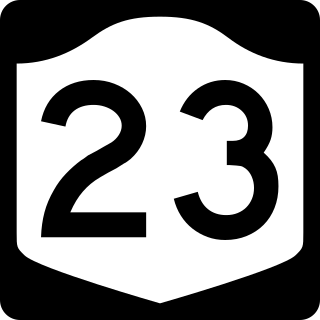
New York State Route 23 (NY 23) is an east–west state highway in the eastern portion of New York in the United States. It extends for 156.15 miles (251.30 km) from an intersection with NY 26 in the Central New York town of Cincinnatus in Cortland County to the Massachusetts state line in the Berkshire Mountains, where it continues east as that state's Route 23. Along the way, it passes through many communities, including the cities of Norwich and Oneonta. Outside of the communities, the route serves largely rural areas of the state and traverses the Catskill Mountains in the state's Central New York Region. NY 23 crosses the Hudson River at Catskill via the Rip Van Winkle Bridge.

New York State Route 385 (NY 385) is a state highway in Greene County, New York, in the United States. It runs from the village of Catskill to the village of Coxsackie, serving as an alternate route of U.S. Route 9W between the two locations. While US 9W follows a more inland routing, NY 385 runs along the Hudson River and serves the village of Athens. Modern NY 385 is the original routing of US 9W between Catskill and Coxsackie. NY 385 was originally assigned c. 1932 to what is now US 9W between Catskill and Coxsackie; however, the alignments of both routes were flipped by the following year.
The Newburgh and Cochecton Turnpike was a turnpike road in southern New York in the United States. It ran from Newburgh on the Hudson River west to Cochecton on the Delaware River, where travelers could continue west through Pennsylvania on the Cochecton and Great Bend Turnpike toward Binghamton. The road operated as a toll road from 1810 to 1872. It is now mostly maintained by the state, carrying New York State Route 17K (NY 17K) from Newburgh to Bloomingburg and NY 17B from Monticello to Fosterdale. Between Bloomingburg and Monticello, the turnpike has been bypassed by the Quickway (NY 17), and is now maintained by Sullivan County; similarly, the route west of Fosterdale to Cochecton is County Route 114 (CR 114). Across the Delaware River, Pennsylvania Route 371 (PA 371) leads west from the Cochecton–Damascus Bridge.
The Lausanne–Nescopeck Turnpike or Susquehanna & Lehigh Turnpike (1804–1840s), also mentioned often as the Lehigh–Susquehanna Turnpike and opened in 1805, was a highly profitable foot traffic toll road established during the earliest days of the American canal age—one of the many privately funded road projects established after the 1790s in the first years of the young United States era to open up and promote growth along either side of the American Frontiers by building connecting transport infrastructure.
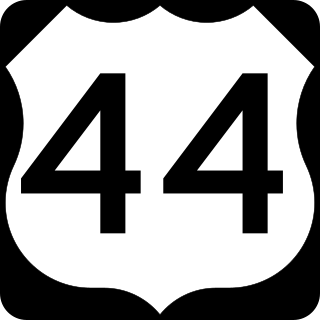
U.S. Route 44 (US 44) is an east–west United States Numbered Highway that runs for 237 miles (381 km) through four states in the Northeastern United States. The western terminus is at US 209 and New York State Route 55 (NY 55) in Kerhonkson, New York, a hamlet in the Hudson Valley region. The eastern terminus is at Route 3A in Plymouth, Massachusetts.



















